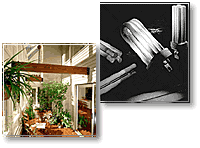L2. Replace Incandescent Lighting with Fluorescent Lighting in Common Areas
Description
Standard incandescent bulbs use three to four times more electricity than fluorescent lamps. In many public housing developments, incandescent lamps burn up to 24 hours per day in common areas such as stairwells, hallways, basements, community rooms, lobbies, and exit signs. By replacing these incandescent lamps with fluorescent lamps, a PHA can save up to 75 percent on the electricity used to light these spaces. In addition, because fluorescent lamps last up to six times longer than incandescent lamps, the PHA saves on replacement and maintenance costs.
For replacement of incandescent lamps in common areas, the most appropriate type of fluorescent lighting is usually a compact fluorescent lamp (CFL). Advances in technology over the past few years have brought great improvements to CFLs in terms of light quality and appearance, and CFLs now come in a variety of shapes and sizes.
Although the initial cost of CFLs is high relative to incandescent lamps, the energy savings and reduced time and expense from lamp replacement make CFLs a cost effective energy conservation measure for many applications. Because the energy savings from a CFL depends on the number of hours the lamp is on, CFLs should be installed in areas with the heaviest use, such as the kitchen, bathroom, and hallways. There is a fair amount of variation in the light output (lumens) per watt of CFLs. To save on energy costs first choose the bulb with the light output you need, then choose the one with the lowest watts. The ENERGY STAR lumen chart will help you determine the lumens you need.
Applicability
- Multifamily buildings with incandescent lighting in common areas
Types
- Screw-in lamps that fit into existing lamp fixtures, just as incandescent bulbs do
- Hard-wired fixtures consisting of a ballast and a lamp socket that are permanently wired into a fixture
Considerations
- Care should be taken to ensure the light output of a CFL, measured in lumens, is adequate for a particular location.
- CFLs should be selected in appropriate sizes and shapes.
- Elderly residents often require higher light levels than younger people due to reduced vision capabilities.
- The light output of some CFLs can decrease over time.
- When theft is a problem, hard-wired CFLs should be selected.
- CFLs are not compatible with dimming switches, unless they come with a special dimming ballast.
- Generally, fixtures should be replaced by qualified contractors.
- If halogen torchiere lamps are used in common areas, they should be replaced with CFL torchieres. Halogens can cause burns and fires due to their high heat output.
Performance/Economics
- Replacing incandescent bulbs with fluorescent lamps will save as much as 75 percent of the electricity cost per lamp.
- CFLs used three hours per day can have a payback period of less than one year.
- Replacing a 100-watt incandescent bulb with an ENERGY STAR qualified CFL can save you $35-$40 in electricity costs over the life of the bulb.
- Because CFLs last up to six times longer than incandescent lamps, the PHA saves on replacement and maintenance costs.
Resources/Links
Energy Conservation for Housing – A Workbook, HUD, September 1998. Pages 7-117 through 7-120 address replacing incandescent lighting with compact fluorescent lamps in common areas.
Energy Performance Contracting for Public and Indian Housing: A Guide for Participants, HUD, February 1992. Pages 27 and 28 address lighting upgrades using performance contracting.
Improving Energy Efficiency in Apartment Buildings, American Council for an Energy-Efficient Economy, 1995. ISBN 0-918249-23-6. Pages 119 through 121 address energy-efficient lighting upgrades.
ENERGY STAR Program: Compact Fluorescent Light Bulbs. Addresses the energy-saving potential of CFLs, provides a buyer's guide, and includes a savings calculator. A tool is available on the ENERGY STAR site for property managers to find lighting and electrical distributors that are ENERGY STAR Partners. The distributors are sorted by state. These distributors may carry some or all of the following ENERGY STAR qualified product categories: ceiling fans, compact fluorescent lamps, exit signs, programmable thermostats, residential lighting fixtures and ventilating fans. HUD does not endorse any specific vendor.
Consumer Guide to Home Energy Savings, American Council for an Energy Efficient Economy, 1999, ISBN 0-918249-38-4. Chapter 11 addresses energy-efficient lighting upgrades.
Lighting. Part of the U.S. Department of Energy's Consumer's Guide. Learn about lighting design, controls, types, and maintenance.
|
TURN OFF UTILITIES: Turn off electricity, gas, propane, and other utilities before starting repairs, cleaning, or installations to avoid accident or injury. BE AWARE OF LEAD-BASED PAINT HAZARDS: Many residences built before 1978 have paint that contains lead, which can pose a serious health hazard if paint, chips, and dust are not handled properly. See the U.S. Environmental Protection Agency (EPA) lead brief before disturbing painted surfaces in homes of this vintage. Follow the HUD "Lead-Safe Housing Rule" for requirements for notification, evaluation and reduction of lead-based paint hazards. BE AWARE OF ASBESTOS HAZARDS: Homes older than 1977 may have building products that contain asbestos such as insulation, high-temperature gaskets, roofing and siding shingles, and vinyl sheet flooring. See the EPA asbestos brief before disturbing such materials. BE AWARE OF MOLD AND MOISTURE HAZARDS: Molds can gradually destroy materials they grow on; can irritate the eyes, skin, nose, throat, and lungs of both mold-allergic and non-allergic people; can cause asthma attacks in people with asthma who are allergic to mold; and can cause other serious health problems. To learn more about preventing and cleaning up mold in homes, see these mold guides and the EPA brief on What to Wear When Cleaning Moldy Areas. |